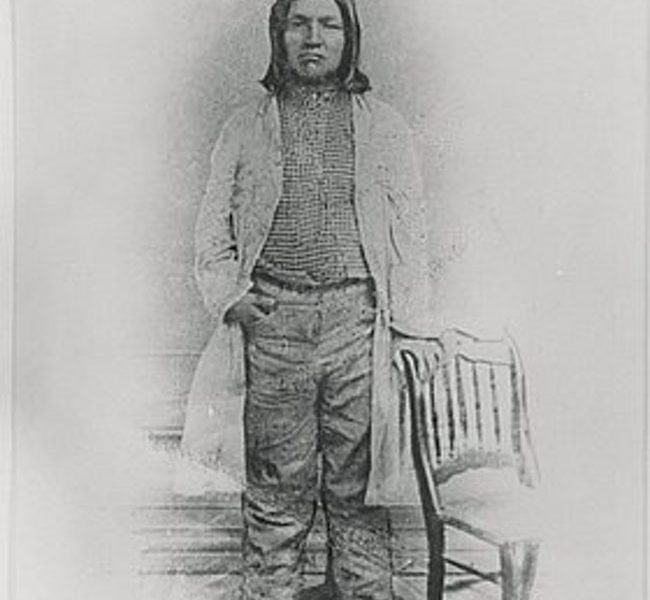
A sketch of Chief Quinaby, c.1870. (Courtesy Oregon Hist. Soc. Research Lib., OrHi76207)
The Salem Art Association currently has an exhibit, “Native Salem,” featuring the history and culture of the original Kalapuyans who lived here for thousands of years, in the area we now know as Salem.
While exploring the exhibit, I learned about a Chemeketan fellow known as Chief Quinaby. He seemed like quite a colorful character. I was very interested in learning more about his life in Salem, so I set about researching to see what I could find out about him just by looking through Salem’s historic newspapers.
Where did Quinaby come from? Historian David Lewis states in his exhibit that Quinaby was a Tsimikiti Kalapuya Indian, who traditionally occupied the territory now known as Salem who became a member of the Confederated Tribes of the Grand Ronde. This Confederation is comprised of over 30 Tribes and bands from western Oregon, northern California and southwest Washington and include tribal bands from the Kalapuya, Mollalla, Chasta, Umpqua, Rogue River, Chinook and Tillamook. Given the large number of tribal bands that were relocated to the Grand Ronde Reservation in 1856 and 1857, it appeared as though early residents of Salem did not always have a clear understanding of which Tribe Indigenous people like Quinaby came from. He was referred to as a Mollalla Indian, a Tribe from central Oregon, who were relocated to the Grand Ronde community. Another Statesman article from 1888 stated that Quinaby was a sub-chief of a Rogue River Tribe.
Where did Quinaby live? In 1872, the Weekly Oregon Statesman reported that General Quinaby and his wife received a Certificate of Assignment for “Lot 1” on the Grand Ronde Reservation. This land was comprised of 20 acres which he could use to farm and build a house. The article noted that the Superintendent of Indian Affairs would be granting about 150 of these Certificates to Grand Ronde families. There are many reports in the Weekly Statesman of Quinaby’s work in Salem along with reports of his home, a ‘wickiup’ in the brush along the creek near the present-day location of Salem’s train depot.
A report about Quinaby in the Ladd & Bush Quarterly published in 1914 included a drawing of Quinaby along with details about his camp which was for a long time located north of Judge Waldo’s house near the creek where Quinaby enjoyed hosting gambling games along with “Whiskey Jim,” another Molalla Indian. The account also told how he would spend his Sunday mornings at the corner of State and Commercial Streets “holding up the corner of Bill Griswold’s building”.
What kind of work did Quinaby do? In 1863, the Weekly Oregon Statesman referred to the Chief as “General Heapasawwood Quinaby” in an article about Quinaby’s business, which was cutting wood for Salem residents and businesses. His wood cutting business was mentioned several more times until 1880, including the report of a fight between Quinaby and another wood cutter in Salem over business. After his death, his work was also mentioned in the regular news feature in the Oregon Statesman “Bits for Breakfast” by R.J. Henricks who wrote that Quinaby would contract with Salem residents to provide them a cord of wood for $1 and then hire Chinese men to complete the work for half the price. Henricks notes that later he decided he would get to keep more money if his wife did the work chopping the wood for him.
 Eliza Quinaby. (Courtesy Oregon Hist. Soc. Research Lib., 019321)
Eliza Quinaby. (Courtesy Oregon Hist. Soc. Research Lib., 019321)
How and when did Quinaby die? It is estimated that Quinaby died at Christmastime in 1882/1883. There are many reports in the Statesman which relay the story of how too much Christmas food allegedly killed Chief Quinaby.
The earliest report of his death was in February of 1888 in the Oregon Statesman: “Old residents of Salem remember the old Indian Quinaby, a sub-chief of the Rogue River tribe, who was in years gone by a land-mark of the capital city. When his tribe were removed to the Grand Ronde reservation, he wouldn’t live there with them. The wild spirit of independence and freedom asserted itself in this unkempt child of nature, so he came and took up his abode in the suburbs of Salem. He was a regular character on the streets … At Christmas times Quinaby would go about from house to house with a sack which he would fill up with the cast-off delicacies from the kitchens of Salem, for every body was a friend of (Quinaby). But on a Christmas six of seven years ago he was treated a little too well, for he filled himself up so full that he died.”
This story of his death was retold often in the Statesman, especially around Christmastime. In 1949 the Statesman ran the article: “Too Much Christmas Food Fatal to Indian Chief in Salem in 1883.” This article provided additional details including a tale that on Christmas Day in 1883 Quinaby had stopped by the home of Lew Griffith, located at the corner of 12th and Court Streets in Salem. He was hungry and cold, and there had been a big wedding feast at the Griffith home the night before. Griffith offered the remains of this wedding feast to Chief Quinaby which he ate all of, causing his death.
In 1989 students at Bush Elementary school dedicated a garden to Chief Quinaby who they believe is buried on the grounds of the school. Five Bush School sixth graders wrote a book called “Chief Quinaby of Salem” and Governor Neil Goldschmidt congratulated the students for their work on the garden and the book.
My hope is that through our continued research, we will be able to learn more about the lives of indigenous people like Chief Quinaby and his wife Eliza and work with interested Tribes to install meaningful interpretation on sites throughout Salem.
You can read more about Chief Quinaby in his Oregon Encyclopedia article.
Editor’s note: This column is part of an effort from Salem Reporter to highlight local history in collaboration with area historians and historical organizations. If you have any feedback or would like to participate in Salem Reporter’s local history series, please contact managing editor Rachel Alexander at [email protected].
JUST THE FACTS, FOR SALEM – We report on your community with care and depth, fairness and accuracy. Get local news that matters to you. Subscribe to Salem Reporter starting at $5 a month. Click I want to subscribe!









